
Gentiana acaulis, the stemless gentian, or trumpet gentian, is a species of flowering plant in the family Gentianaceae, native to central and southern Europe, from Spain east to the Balkans, growing especially in mountainous regions, such as the Alps and Pyrenees, at heights of 800–3,000 m (2,625–9,843 ft).

Gelsemium sempervirens is a twining vine in the family Gelsemiaceae, native to subtropical and tropical America: Honduras, Guatemala, Belize, Mexico, and southeastern and south-central United States. It has a number of common names including yellow jessamine or jasmine, Carolina jasmine or jessamine, evening trumpetflower, gelsemium and woodbine.
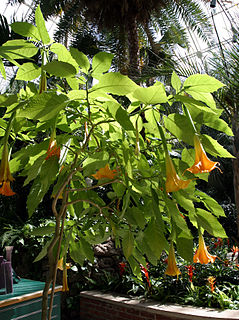
Brugmansia is a genus of seven species of flowering plants in the family Solanaceae. They are woody trees or shrubs, with pendulous flowers, and have no spines on their fruit. Their large, fragrant flowers give them their common name of angel's trumpets, a name sometimes used for the closely related genus Datura..

Cassia fistula, commonly known as golden shower, purging cassia, Indian laburnum, or pudding-pipe tree, is a flowering plant in the subfamily, Caesalpinioideae of the legume family, Fabaceae. The species is native to the Indian subcontinent and adjacent regions of Southeast Asia. It ranges from eastward throughout India to Myanmar and Thailand and south to Sri Lanka and southern Pakistan. It is a popular ornamental plant and is also used in herbal medicine. It is both the national tree and national flower of Thailand. It is the state flower of Kerala in India.
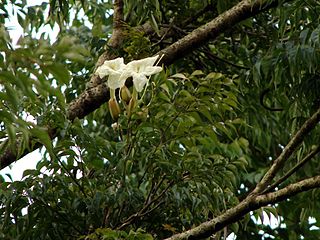
Radermachera sinica, also called china doll, serpent tree or emerald tree, is an evergreen tree in the family Bignoniaceae, native to the subtropical mountain regions of southern China and Taiwan. It can reach heights of up to 30 m tall and a trunk diameter of 1 m. The leaves are bipinnate, 20 to 70 cm long and 15 to 25 cm broad, divided into numerous small glossy green leaflets 2 to 4 cm long. The flowers are white, trumpet-like, about 7 cm long, and resembling a large Bignonia flower in shape. The flowers are night-blooming and only last for one night, wilting in the morning sun. The blooms appear spring to early summer, and are highly fragrant.

Albizia julibrissin, the Persian silk tree or pink silk tree, is a species of tree in the family Fabaceae, native to southwestern and eastern Asia.
Trumpetflower or trumpet flower may refer to several plants:
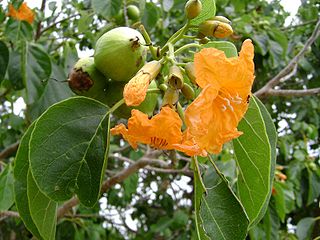
Cordia subcordata is a species of flowering tree in the borage family, Boraginaceae, that occurs in eastern Africa, South Asia, Southeast Asia, northern Australia and the Pacific Islands. The plant is known by a variety of names including beach cordia, sea trumpet, and kerosene wood, among others.

Alloxylon flammeum, commonly known as the Queensland tree waratah or red silky oak, is a medium-sized tree of the family Proteaceae found in the Queensland tropical rain forests of northeastern Australia. It has shiny green elliptical leaves up to 18 cm (7.2 in) long, and prominent orange-red inflorescences that appear from August to October, followed by rectangular woody seed pods that ripen in February and March. Juvenile plants have large deeply lobed pinnate leaves. Previously known as Oreocallis wickhamii, the initial specimen turned out to be a different species to the one cultivated and hence a new scientific name was required. Described formally by Peter Weston and Mike Crisp in 1991, A. flammeum was designated the type species of the genus Alloxylon. This genus contains the four species previously classified in Oreocallis that are found in Australasia.

Magnolia kobus, known as mokryeon, kobus magnolia, or kobushi magnolia, is a species of Magnolia native to Japan and Korea and occasionally cultivated in temperate areas. It is a deciduous, small to tall tree which has a slow rate of growth but can reach 8–15 m (25–50 ft) in height and up to 10 m (35 ft) in spread.
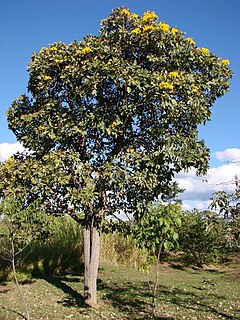
Tabebuia aurea is a species of Tabebuia native to South America in Suriname, Brazil, eastern Bolivia, Peru, Paraguay, and northern Argentina. The common English name Caribbean trumpet tree is misleading, as it is not native to the Caribbean. It is also known as the silver trumpet tree, and tree of gold.

Tabebuia rosea, also called pink poui, and rosy trumpet tree, or Indian Cherry Blossom is a neotropical tree that grows up to 30 m (98 ft) and can reach a diameter at breast height of up to 100 cm (3 ft). The Spanish name roble de sabana, meaning "savannah oak", is widely used in Costa Rica, probably because it often remains in heavily deforested areas and because of the resemblance of its wood to that of oak trees. It is the national tree of El Salvador, where it is called "Maquilíshuat".

Cercidiphyllum japonicum, known as the katsura, is a species of flowering tree in the family Cercidiphyllaceae native to China and Japan. It is sometimes called caramel tree for the light caramel smell it emits during leaf fall.

Dolichandrone spathacea, also known as tui or mangrove trumpet tree, is a species of plant in the family Bignoniaceae. It is found from South India, Sri Lanka to New Caledonia.
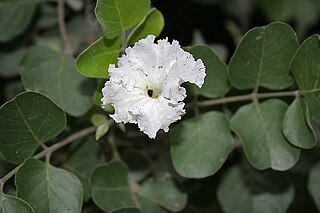
Dolichandrone falcata is a small deciduous tree in the family Bignoniaceae. It is endemic to India. Tree attains a height of 15–20 feet. Leaves are compound 2-6 inches long with 3-6 obovate or oval shaped leaflets. Flowers are white and fragrant. Flowering occurs in April–May.
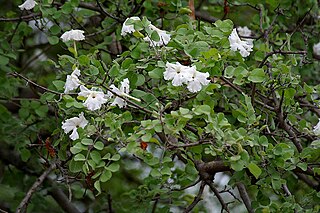
Dolichandrone is a genus of flowering plants in the family Bignoniaceae.

Dolichandrone alba, also known as indani or tsanie, is a small deciduous shrub or small tree in the family Bignoniaceae. It is endemic to southern Mozambique.

Markhamia stipulata is a species of plant in the family Bignoniaceae. It is native to South China and Southeast Asia. This species usually grows as a tall tree, reaching heights of 5–15 m. Stipulata thrives in sparsely treed areas, such as fields. Flowers are pale yellow to reddish brown.

Agave atrovirens, called maguey verde grande is a type of century plant native to Oaxaca, Pueblo and Veracruz states in Mexico. It is the largest of all the Agaves, occasionally reaching a weight of two long tons. Each succulent leaf can be up to 14 feet 9 inches in length and weigh one hundred pounds (45 kg) apiece. In the variety A. a. cochlearis these leaves can also be up to 16 inches (41 cm) wide. As in other Agaves the leaves form a rosette, from the center of which, after many years, a panicle of flowers emerges on a long scape or peduncle which at first looks like a vast stalk of asparagus, but later grows to more than forty feet in height, develops side branches near the top and numerous flowers which open red and gradually turn yellow. Agave salmiana, the species with the tallest inflorescences, is frequently lumped with A. atrovirens as the varieties A. a. salmiana or A. a. sigmatophylla. If this is valid, then A. atrovirens also has the largest inflorescences of any Agave, and of any known plant. Each rosette flowers and fruits once, then dies. According to Fayaz this is one of the species which makes offsets or "pups". A. atrovirens is one of the pulque agaves used in the production of mezcal.
Dolichandrone arcuata, known in Malayalam as pambukaimaram, is a deciduous tree in the Bignoniaceae family. This species is native to the dry, deciduous forests of the Eastern Ghats in the Indian subcontinent. It is a medium-sized tree, reaching up to 16 m (52 ft) in height.


















